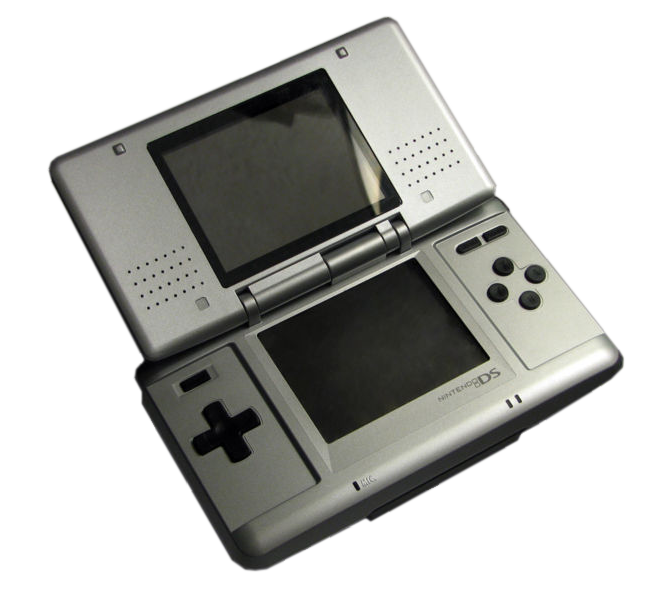Technical specifications for Original Gameboy

CPU: Custom 8-bit Sharp LR35902[36] (Z80-clone) core at 4.19 MHz which is similar to an Intel 8080 in that all of the registers introduced in the Z80 are not present. However, some of the Z80's instruction set enhancements over the stock 8080, particularly bit manipulation, are present. Still other instructions are unique to this particular flavor of Z80 CPU. The core also contains integrated sound generation
RAM: 8 kB internal S-RAM
Video RAM: 8 kB internal
ROM: On-CPU-Die 256-byte bootstrap; 256 kb, 512 kb, 1 Mb, 2 Mb, 4 Mb and 8 Mb cartridges
Sound: 2 Square Waves, 1 programmable 32-sample 4-bit PCM Wave, 1 White noise. The unit only has one speaker, but headphones provide stereo sound (for further information, see Game Boy music)
Display: Reflective LCD 160 × 144 pixels
Screen size: 66 mm (2.6 in) diagonal
Color Palette: 4 shades of "gray" (green to (very) dark green)
Communication: Up to 2 Game Boys can be linked together via built-in serial ports, up to 4 with a DMG-07 4-player adapter. More than 4 players is possible by chaining adapters.
Power: 6 V, 0.7 W (4 AA batteries provide ~35 hours)
Dimensions: 90 mm (W) x 148 mm (H) x 32 mm (D) / 3.5" x 5.8" 1.3" (in)

CPU: Custom 8-bit Sharp LR35902[36] (Z80-clone) core at 4.19 MHz which is similar to an Intel 8080 in that all of the registers introduced in the Z80 are not present. However, some of the Z80's instruction set enhancements over the stock 8080, particularly bit manipulation, are present. Still other instructions are unique to this particular flavor of Z80 CPU. The core also contains integrated sound generation
RAM: 8 kB internal S-RAM
Video RAM: 8 kB internal
ROM: On-CPU-Die 256-byte bootstrap; 256 kb, 512 kb, 1 Mb, 2 Mb, 4 Mb and 8 Mb cartridges
Sound: 2 Square Waves, 1 programmable 32-sample 4-bit PCM Wave, 1 White noise. The unit only has one speaker, but headphones provide stereo sound (for further information, see Game Boy music)
Display: Reflective LCD 160 × 144 pixels
Screen size: 66 mm (2.6 in) diagonal
Color Palette: 4 shades of "gray" (green to (very) dark green)
Communication: Up to 2 Game Boys can be linked together via built-in serial ports, up to 4 with a DMG-07 4-player adapter. More than 4 players is possible by chaining adapters.
Power: 6 V, 0.7 W (4 AA batteries provide ~35 hours)
Dimensions: 90 mm (W) x 148 mm (H) x 32 mm (D) / 3.5" x 5.8" 1.3" (in)
 Mass: 275 grams (9.7 ounces).
Mass: 275 grams (9.7 ounces).Physical dimensions: 148.7 x 84.7 x 28.9 mm (5.85 x 3.33 x 1.13 inches).
Screens: Two separate 3-inch TFT LCD, resolution of 256 x 192 pixels, dimensions of 62 x 46 mm and 77 mm diagonal, and a dot pitch of 0.24 mm. The gap between the screens is approximately 21 mm, equivalent to about 92 "hidden" lines. The lowermost display of the Nintendo DS is overlaid with a resistive touchscreen, which registers pressure from one point on the screen at a time, averaging multiple points of contact if necessary.
CPUs: Two ARM processors, an ARM946E-S main CPU and ARM7TDMI co-processor at clock speeds of 67 MHz and 33 MHz respectively. The ARM946E-S CPU processes 3D rendering and the ARM7TDMI processes 2D rendering for DS games and Game boy Advance gameplay.
RAM: 4 MB of Mobile RAM
Voltage: 1.65 volts required
Storage: 256 kB of Serial Flash Memory
Wireless: 802.11 + Nintendo Original Protocol
Wi-Fi: Built-in 802.11 Wireless Network Connection (802.11b compatible with WEP encryption support only)[22]
Despite this enormous gap in technology, the original gameboy can make amazing music with the help of only two mods: a Flash Cartridge with Little Sound Dj or Nanoloop and a Prosound modification. Custom painting may also be desired in order to give it that extra "cool" factor. Luckily for all those technically challenged and lazy musicians out there Nonfinite offers pre-modded systems. These simple modifications make the Gameboy a viable instrument by adding a much higher quality 4-bit sound. The Prosound modification makes the output louder while reducing hiss and the Flash Cartridge with the music interface programs allows any musician to make music in no time. The Little Sound Dj is essentially a sequencer designed for the 4-bit processor, which can also be used with a variety of samples including the famed TR-808. Nanoloop on the other hand is a step sequencer that loops 16 1/16 notes with a incredibly easy interface. Gameboy musicians tend to use these two programs, though others do exist, and usually describe Little Sound Dj as having a slight learning curve. However, the program's both have their merits.
Though music can be made on other Gameboy systems, the original system is the best in audio quality and "retro" feel. This Gameboy artist's site probably has the best description of the different sounds that can be obtained. Hopefully, as this musical scene grows more excellent artists will experiment with the sonic possibilities that can be obtained. I have already heard one excellent band called Pornophonique. They describe themselves on the site as "gameboy meets lagerfeuer" and have a most excellent sound. I suggest checking them out and keeping your eyes open for any new groups utilizing the Gameboy as an instrument.





No comments:
Post a Comment